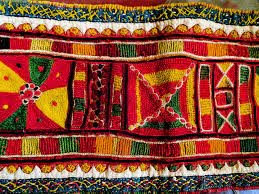Description

Disclaimer: Copyright infringement not intended.
Context
Porgai Artisan Association Society, with 60 plus women, has been making and selling embroidered clothes to ensure that there is awareness about the art form and that it is passed onto the next generation.
Details
History of Tamil Lambadi Art
- Origins in the Tamil Nadu region of India.
- Rooted in the cultural practices and traditions of the Lambadi community.
- Influenced by historical, social, and religious factors within the community.
Characteristics of Tamil Lambadi Art
- Vibrant color schemes with a focus on bold and contrasting hues.
- Intricate embroidery and mirror work that embellish textiles and clothing.
- Symbolic representations of nature, folklore, and traditional beliefs.
- Usage of geometric patterns and intricate designs to create visually appealing art forms.
- Incorporation of traditional Lambadi motifs and symbols passed down through generations.

Significance of Tamil Lambadi Art
- Reflects the rich cultural heritage and identity of the Lambadi community.
- Serves as a medium for storytelling and preserving cultural narratives.
- Symbolizes the community's close connection with nature and its surroundings.
- Represents the vibrant lifestyle and celebratory spirit of the Lambadi people.
Notable Elements of Tamil Lambadi Art
- Lambadi Textiles: Intricately embroidered textiles adorned with mirrors, beads, and vibrant threads.
- Lambadi Jewelry: Ornate and colorful jewelry pieces, often made using traditional techniques and materials.
- Lambadi Paintings: Artistic representations on fabric or canvas that depict the community's folklore, traditions, and daily life.
- Lambadi Dance and Music: Traditional dance forms and music that accompany various cultural celebrations and rituals within the community.
Lambadi Language: A Nomadic Dialect
- Origins and Nomadic Heritage: Reflects the cultural heritage and historical migration patterns of the Lambadi community.
- Regional Dialects and Script Usage: Written using the scripts of dominant languages in respective regions (e.g., Devanagari, Kannada, Tamil, or Telugu script).
- Bilingualism and Regional Integration: Proficiency in Telugu, Kannada, or Marathi depending on geographical location and neighboring communities.
Lambadi Dance
- Cultural Significance and Historical Context: Reflects community spirit, celebratory traditions, and historical narratives.
- Characteristics of the Lambadi Dance Form: Characterized by graceful movements, rhythmic footwork, and expressive gestures, often performed with metal pots on the head.
- Attire and Jewelry in Lambadi Dance Performances: Colorful dresses with embroidery and mirrors, accompanied by beaded jewelry, symbolizing cultural richness and vitality.

Conclusion
Tamil Lambadi art continues to be a significant aspect of the cultural landscape in Tamil Nadu, serving as a testament to the rich cultural heritage and artistic traditions of the Lambadi community.
|
PRACTICE QUESTION
Q. Which of the following statements about the Lambadi community in India is true?
1. Lambadi is a language spoken by the once nomadic Lambadi Banjara people across India.
2. Lambadi language is often written in the scripts of the regions where it is spoken.
3. Lambadi dance is a traditional form performed by Banjari women, often characterized by balancing metal pots on their heads.
Options:
a) Statement 1 and 2 are true.
b) Statement 2 and 3 are true.
c) Statement 1 and 3 are true.
d) All three statements are true.
Answer: d)
|
















